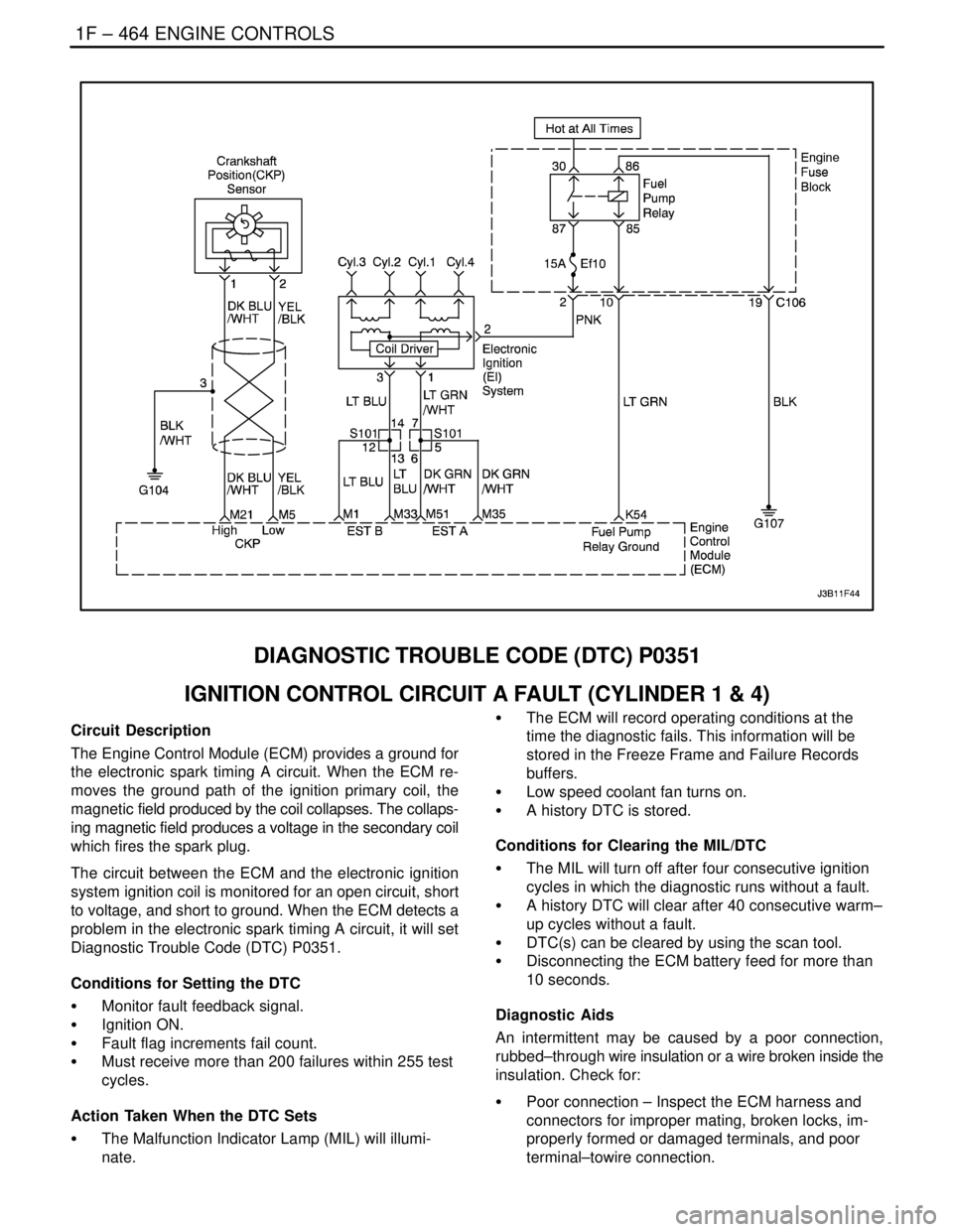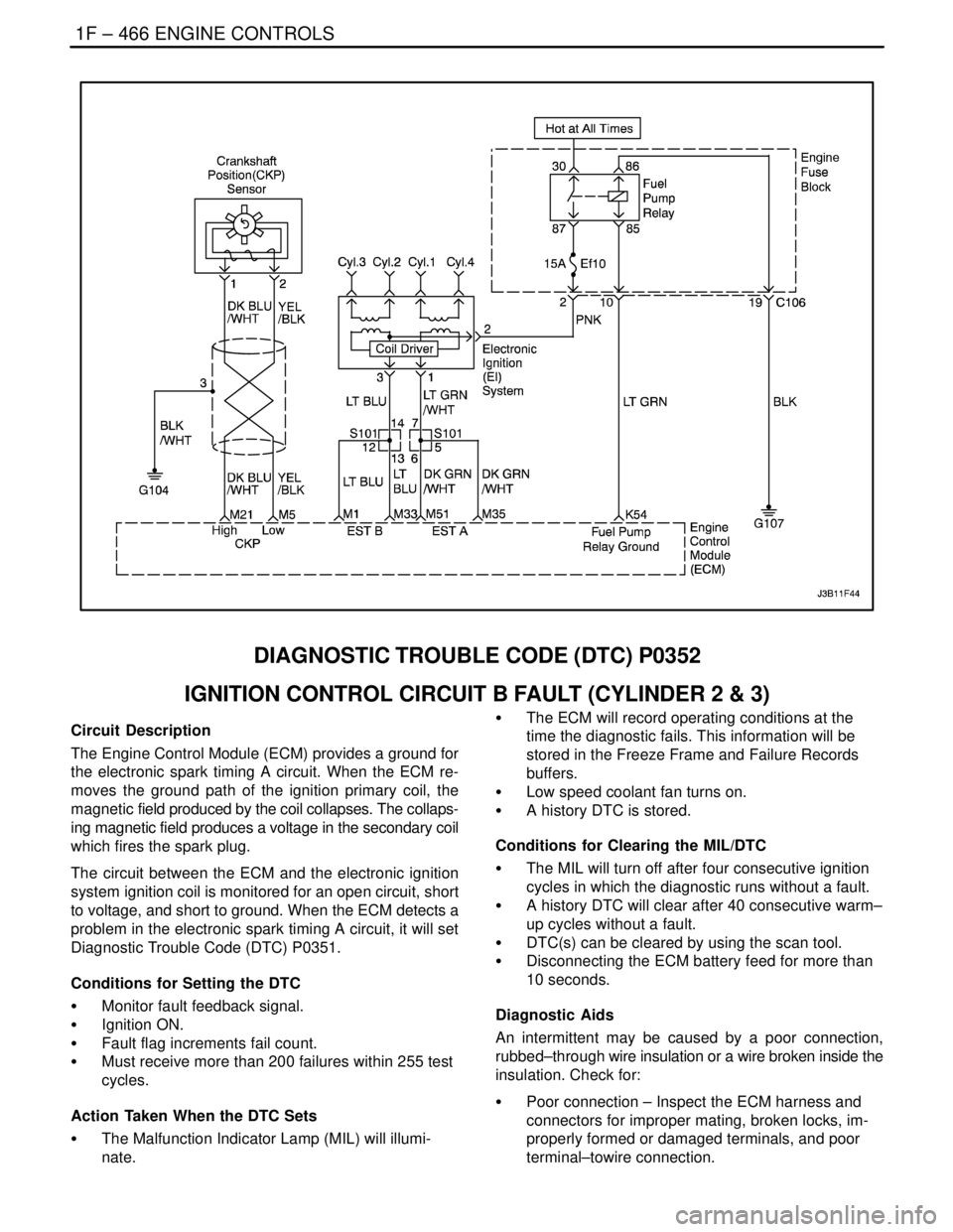2004 DAEWOO LACETTI engine coolant
[x] Cancel search: engine coolantPage 687 of 2643

ENGINE CONTROLS 1F – 441
DAEWOO V–121 BL4
DIAGNOSTIC TROUBLE CODE (DTC) P0304
CYLINDER 4 MISFIRE
System Description
The Engine Control Module (ECM) monitors the crank-
shaft and camshaft positions to detect if the engine is mis-
firing. The ECM looks for a quick drop in crankshaft speed.
This test is executed in blocks of 100 engine revolution
tests. It may take between one to several tests to store a
Diagnostic Trouble Code (DTC) and illuminate the Mal-
function Indicator Lamp (MIL). Under light misfire condi-
tions, it may also take more than one trip to set a DTC. Se-
vere misfire will flash the MIL, indicating that catalyst
damage is possible.
Conditions for Setting the DTC
S Emission threshold is 3%.
S 20 engine cycles have occurred since cranking has
started.
S A/C compressor clutch has not just engaged or dis-
engaged.
S Engine load and engine speed is in a detectable
region and is at or above zero torque.
S Camshaft Position (CMP) sensor is in synchroniza-
tion.
S Exhaust Gas Recirculation (EGR) flow diagnostic is
not in progress.
S Fuel level is greater than 12% of rated tank capac-
ity.
S Decel Fuel Cutoff (DFCO) not active.
S Throttle position change is less than 3% per 125
ms.
S Vehicle has not encountered an abusive engine
speed of 7000 rpm.
S Crankshaft speed patters are normal.
S Throttle position is less than 3% when vehicle
speed is greater than 10 km/h (6 mph).
S Vehicle voltage is between 11 and 16 volts.
S Engine Coolant Temperature (ECT) is between
–7°C (19°F) and 120°C (248°F).
S There is the correct ratio between Crankshaft Posi-
tion (CKP) sensor pulses and CMP sensor pulses.
S DTCs P0106, P0107, P0108, P0117, P0118,
P0122, P0123, P0336, P0337, P0341, P0342 and
P0502 are not set.
Action Taken When the DTC Sets
S The MIL will illuminate after two consecutive ignition
cycles in which the diagnostic runs with the fault
active.
Or
S The MIL will illuminate immediately and flash if mis-
fire is present.
S The ECM will record operating conditions at the
time the diagnostic fails. This information will be
stored in the Freeze Frame and Failure Records
buffers.S A history DTC is stored.
Conditions for Clearing the MIL/DTC
S The MIL will turn off after four consecutive ignition
cycles in which the diagnostic runs without a fault
within the freeze frame conditions that the DTC
failed.
S A history DTC will clear after 40 consecutive warm–
up cycles without a fault.
S The DTC(s) can be cleared by using the scan tool.
S Disconnecting the ECM battery feed for more than
10 seconds.
Diagnostic Aids
An intermittent can also be the result of a defective reluctor
wheel. Remove the CKP sensor and inspect the reluctor
wheel through the sensor mount hole. Check for porosity
and the condition of wheel. If the DTC is intermittent refer
to”Symptoms Diagnosis” in this section.
Test Description
Number(s) below refer to the step number(s) on the Diag-
nostic Table.
1. The On–Board Diagnostic (EOBD) System Check
prompts the technician to complete some basic
checks and store the freeze frame and failure re-
cords data on the scan tool if applicable. This
creates an electronic copy of the data taken when
the malfunction occurred. The information is then
stored on the scan tool for later reference.
3. A visual/physical inspection should include check-
ing the following components:
S The wiring for proper connections, pinches or
cuts.
S The ECM grounds for being clean and tight.
S The vacuum hoses for splits, kinks, and proper
connections as shown on the Vehicle Emission
Information label. Check thoroughly for any type
of leak or restriction.
S For air leaks at the throttle body mounting area
and intake manifold sealing surfaces.
5. When all the accumulators are relatively equal, then
the misfire is being caused by something that af-
fects the entire engine. When they are not then the
misfire is being caused by something that is specif-
ic to two or more cylinders.
6. Whenever the misfire is not present operating the
vehicle may be necessary to duplicate the condi-
tions in the Freeze Frame Data in order to detect
misfire. Depending on the engine load, the condi-
tions may have to be maintained for up to 20 sec-
onds. Whenever the misfire accumulators start to
increment, then misfire is present. A history misfire
counter will store the number of misfires that have
occurred until the DTC is cleared.
Page 710 of 2643

1F – 464IENGINE CONTROLS
DAEWOO V–121 BL4
DIAGNOSTIC TROUBLE CODE (DTC) P0351
IGNITION CONTROL CIRCUIT A FAULT (CYLINDER 1 & 4)
Circuit Description
The Engine Control Module (ECM) provides a ground for
the electronic spark timing A circuit. When the ECM re-
moves the ground path of the ignition primary coil, the
magnetic field produced by the coil collapses. The collaps-
ing magnetic field produces a voltage in the secondary coil
which fires the spark plug.
The circuit between the ECM and the electronic ignition
system ignition coil is monitored for an open circuit, short
to voltage, and short to ground. When the ECM detects a
problem in the electronic spark timing A circuit, it will set
Diagnostic Trouble Code (DTC) P0351.
Conditions for Setting the DTC
S Monitor fault feedback signal.
S Ignition ON.
S Fault flag increments fail count.
S Must receive more than 200 failures within 255 test
cycles.
Action Taken When the DTC Sets
S The Malfunction Indicator Lamp (MIL) will illumi-
nate.S The ECM will record operating conditions at the
time the diagnostic fails. This information will be
stored in the Freeze Frame and Failure Records
buffers.
S Low speed coolant fan turns on.
S A history DTC is stored.
Conditions for Clearing the MIL/DTC
S The MIL will turn off after four consecutive ignition
cycles in which the diagnostic runs without a fault.
S A history DTC will clear after 40 consecutive warm–
up cycles without a fault.
S DTC(s) can be cleared by using the scan tool.
S Disconnecting the ECM battery feed for more than
10 seconds.
Diagnostic Aids
An intermittent may be caused by a poor connection,
rubbed–through wire insulation or a wire broken inside the
insulation. Check for:
S Poor connection – Inspect the ECM harness and
connectors for improper mating, broken locks, im-
properly formed or damaged terminals, and poor
terminal–towire connection.
Page 712 of 2643

1F – 466IENGINE CONTROLS
DAEWOO V–121 BL4
DIAGNOSTIC TROUBLE CODE (DTC) P0352
IGNITION CONTROL CIRCUIT B FAULT (CYLINDER 2 & 3)
Circuit Description
The Engine Control Module (ECM) provides a ground for
the electronic spark timing A circuit. When the ECM re-
moves the ground path of the ignition primary coil, the
magnetic field produced by the coil collapses. The collaps-
ing magnetic field produces a voltage in the secondary coil
which fires the spark plug.
The circuit between the ECM and the electronic ignition
system ignition coil is monitored for an open circuit, short
to voltage, and short to ground. When the ECM detects a
problem in the electronic spark timing A circuit, it will set
Diagnostic Trouble Code (DTC) P0351.
Conditions for Setting the DTC
S Monitor fault feedback signal.
S Ignition ON.
S Fault flag increments fail count.
S Must receive more than 200 failures within 255 test
cycles.
Action Taken When the DTC Sets
S The Malfunction Indicator Lamp (MIL) will illumi-
nate.S The ECM will record operating conditions at the
time the diagnostic fails. This information will be
stored in the Freeze Frame and Failure Records
buffers.
S Low speed coolant fan turns on.
S A history DTC is stored.
Conditions for Clearing the MIL/DTC
S The MIL will turn off after four consecutive ignition
cycles in which the diagnostic runs without a fault.
S A history DTC will clear after 40 consecutive warm–
up cycles without a fault.
S DTC(s) can be cleared by using the scan tool.
S Disconnecting the ECM battery feed for more than
10 seconds.
Diagnostic Aids
An intermittent may be caused by a poor connection,
rubbed–through wire insulation or a wire broken inside the
insulation. Check for:
S Poor connection – Inspect the ECM harness and
connectors for improper mating, broken locks, im-
properly formed or damaged terminals, and poor
terminal–towire connection.
Page 716 of 2643

1F – 470IENGINE CONTROLS
DAEWOO V–121 BL4
DIAGNOSTIC TROUBLE CODE (DTC) P0402
EXHAUST GAS RECIRCULATION EXCESSIVE FLOW
Circuit Description
An Exhaust Gas Recirculation (EGR) system is used to
lower Nitrogen Oxide (NOx) emission levels caused by
high combustion temperatures. It accomplishes this by
feeding small amounts of exhaust gases back into the
combustion chamber. When the air/fuel mixture is diluted
with the exhaust gases, combustion temperatures are re-
duced
A linear EGR valve is used on this system. The linear EGR
valve is designed to accurately supply exhaust gases to
the engine without the use of intake manifold vacuum. The
valve controls exhaust flow going into the intake manifold
from the exhaust manifold through an orifice with an En-
gine Control Module (ECM) controlled pintle. The ECM
controls the pintle position using inputs from the Throttle
Position (TP) and Manifold Absolute Pressure (MAP) sen-
sors. The ECM then commands the EGR valve to operate
when necessary by controlling an ignition signal through
the ECM. This can be monitored on a scan tool as the De-
sired EGR Position.
The ECM monitors the results of its command through a
feedback signal. By sending a 5 volt reference and a
ground to the EGR valve, a voltage signal representing the
EGR valve pintle position is sent to the ECM. This feed-
back signal can also be monitored on a scan tool and is the
actual position of the EGR pintle. The Actual EGR Position
should always be near the commanded or Desired EGR
Position.
This Diagnostic Trouble Code (DTC) will detect an EGR
open to a large valve during crank. Crank time may be ex-
cessive with an open EGR valve.Conditions for Setting the DTC
S EGR position is greater than 70% for more than 3
seconds during cranking.
S Engine cranking (not running).
S Ignition voltage is between 10 and 16 volts.
Action Taken When the DTC Sets
S The Malfunction Indicator Lamp (MIL) will illuminate
after three consecutive with a fail.
S The ECM will record operating conditions at the
time the diagnostic fails. This information will be
stored in the Freeze Frame and Failure Records
buffers.
S A history Diagnostic Trouble Code (DTC) is stored.
S EGR is disabled.
Conditions for Clearing the MIL/DTC
S The MIL will turns off after four consecutive ignition
cycles in which the diagnostic runs without a fault.
S A history DTC will clear after 40 consecutive warm–
up cycles without a fault.
S DTC(s) can be cleared by using the scan tool.
S Disconnecting the ECM battery feed for more than
10 seconds.
Diagnostic Aids
Due to moisture associated with exhaust systems, the
EGR valve may freeze and stick in cold weather at times.
After the vehicle is brought into a warm shop for repairs,
the valve warms and the problem disappears. By watching
the Actual EGR and Desired EGR Positions on a cold ve-
hicle with a scan tool, the fault can be easily verified.
Check the freeze frame data to determine if the DTC set
when the vehicle was cold by viewing the Engine Coolant
Temperature (ECT).
Page 721 of 2643

ENGINE CONTROLS 1F – 475
DAEWOO V–121 BL4
the Actual EGR and Desired EGR Positions on a cold ve-
hicle with a scan tool, the fault can be easily verified.
Check the freeze frame data to determine if the DTC set
when the vehicle was cold by viewing the Engine Coolant
Temperature (ECT).
Test Description
Number(s) below refer to the step number(s) on the Diag-
nostic Table.
1. The On–Board Diagnostic (EOBD) System Check
prompts the technician to complete some basic
checks and store the freeze frame and failure re-
cords data on the scan tool if applicable. This
creates an electronic copy of the data taken when
the malfunction occurred. The information is then
stored on the scan tool for later reference.
2. Commanding the EGR valve open determines
whether the EGR system can control the EGR
valve accurately and if the fault is present. The dif-
ference between the current and commanded posi-
tion is greater than 15%.
3. When the EGR valve electrical connector is discon-
nected, the scan tool should display the Actual
EGR Position as 0%. If it does not, the fault lies
either in the EGR signal circuit or the ECM.
4. There may be a slight delay for the voltage dis-
played on the DVM to change after the scan tool
commands the EGR valve to operate.
5. An open or poor connection condition may have
caused this DTC to set. Be sure to check the termi-
nals for being backed out, improperly formed or
damaged, and for poor tension.
7. The test light will have glowed brightly in the pre-
vious step if the EGR control circuit was shorted to
B+ and the Actual EGR Position on the scan toolwill display 100%. A test light that did not illuminate,
indicates that the circuit may be open or shorted to
ground.
9. If the EGR valve 5 volt reference is shorted to volt-
age, the digital voltmeter (DVM) will read battery
voltage and additional DTCs may be set and the
engine performance will be poor.
12. The replacement ECM must be reprogrammed.
Refer to the latest Techline procedure for ECM re-
programming.
13. Although the circuitry acted correctly when
checked, a problem may still lie within the terminals
which would not show up in probe type testing. Be
sure to check the terminals for being backed out,
improperly formed or damaged, and for poor ten-
sion.
17. All circuits to the EGR valve are OK at this point.
The fault lies internally in the EGR valve and, there-
fore, must be replaced. Be sure all gasket material
is removed from the EGR mounting surface. Even
a small amount of material may cause a DTC
P0401 to set.
18. Check the terminals for being backed out, improp-
erly formed or damaged, and for poor tension.
19. Clearing DTCs is a very important step for this
diagnostic. The clearing function allows the EGR
valve to relearn a new pintle position as the old
pintle position was inaccurate due to the failure that
caused the DTC. The DTC must be cleared with
the ignition ON, engine OFF or when the engine is
idling. If the ECM sees a EGR command, the new
pintle will not be learned.
20. If no malfunctions have been found at this point and
no additional DTCs were set, refer to ”Diagnostic
Aids” in this section for additional checks and infor-
mation.
DTC P0404 – Exhaust Gas Recirculation Open Valve Position Error
StepActionValue(s)YesNo
1Perform an On–Board Diagnostic (EOBD) System
Check.
Was the check performed?–Go to Step 2Go to
”On–Board
Diagnostic Sys-
tem Check”
21. Install a scan tool to the Data Link Connector
(DLC).
2. Turn the ignition ON.
3. Command the Exhaust Gas Recirculation
(EGR) valve to the specific values.
Does the Actual EGR Position follow the Desired
EGR Position?25%, 50%,
75%, 100%Go to Step 19Go to Step 3
31. Turn the ignition OFF.
2. Disconnect the EGR valve.
3. Turn the ignition ON.
4. With a test light connected to B+, probe the
EGR valve wiring harness connector terminal
2.
Does the test light illuminate?–Go to Step 4Go to Step 5
Page 724 of 2643

1F – 478IENGINE CONTROLS
DAEWOO V–121 BL4
DIAGNOSTIC TROUBLE CODE (DTC) P0405
EXHAUST GAS RECIRCULATION PINTLE POSITION LOW
VOLTAGE
Circuit Description
An Exhaust Gas Recirculation (EGR) system is used to
lower Nitrogen Oxide (NOx) emission levels caused by
high combustion temperatures. It accomplishes this by
feeding small amounts of exhaust gases back into the
combustion chamber. When the air/fuel mixture is diluted
with the exhaust gases, combustion temperatures are re-
duced
A linear EGR valve is used on this system. The linear EGR
valve is designed to accurately supply exhaust gases to
the engine without the use of intake manifold vacuum. The
valve controls exhaust flow going into the intake manifold
from the exhaust manifold through an orifice with an En-
gine Control Module (ECM) controlled pintle. The ECM
controls the pintle position using inputs from the Throttle
Position (TP) and Manifold Absolute Pressure (MAP) sen-
sors. The ECM then commands the EGR valve to operate
when necessary by controlling an ignition signal through
the ECM. This can be monitored on a scan tool as the De-
sired EGR Position.
The ECM monitors the results of its command through a
feedback signal. By sending a 5 volt reference and a
ground to the EGR valve, a voltage signal representing the
EGR valve pintle position is sent to the ECM. This feed-
back signal can also be monitored on a scan tool and is the
actual position of the EGR pintle. The Actual EGR Position
should always be near the commanded or Desired EGR
Position. This diagnostic Trouble Code (DTC) will detect
an open or short circuit.Conditions for Setting the DTC
S EGR position signal is less than 2%.
S Ignition voltage is between 11.7 and 16 volts.
S Fail condition last more than 10 seconds.
Action Taken When the DTC Sets
S The Malfunction Indicator Lamp (MIL) will illuminate
after three consecutive ignition cycle with a fail.
S The ECM will record operating conditions at the
time the diagnostic fails. This information will be
stored in the Freeze Frame and Failure Records
buffers.
S A history Diagnostic Trouble Code (DTC) is stored.
S EGR is disabled.
Conditions for Clearing the MIL/DTC
S The MIL will turns off after four consecutive ignition
cycles in which the diagnostic runs without a fault.
S A history DTC will clear after 40 consecutive warm–
up cycles without a fault.
S DTC(s) can be cleared by using the scan tool.
S Disconnecting the ECM battery feed for more than
10 seconds.
Diagnostic Aids
Due to moisture associated with exhaust systems, the
EGR valve may freeze and stick in cold weather at times.
After the vehicle is brought into a warm shop for repairs,
the valve warms and the problem disappears. By watching
the Actual EGR and Desired EGR Positions on a cold ve-
hicle with a scan tool, the fault can be easily verified.
Check the freeze frame data to determine if the DTC set
when the vehicle was cold by viewing the Engine Coolant
Temperature (ECT).
Page 727 of 2643

ENGINE CONTROLS 1F – 481
DAEWOO V–121 BL4
DIAGNOSTIC TROUBLE CODE (DTC) P0406
EXHAUST GAS RECIRCULATION PINTLE POSITION HIGH
VOLTAGE
Circuit Description
An Exhaust Gas Recirculation (EGR) system is used to
lower Nitrogen Oxide (NOx) emission levels caused by
high combustion temperatures. It accomplishes this by
feeding small amounts of exhaust gases back into the
combustion chamber. When the air/fuel mixture is diluted
with the exhaust gases, combustion temperatures are re-
duced
A linear EGR valve is used on this system. The linear EGR
valve is designed to accurately supply exhaust gases to
the engine without the use of intake manifold vacuum. The
valve controls exhaust flow going into the intake manifold
from the exhaust manifold through an orifice with an En-
gine Control Module (ECM) controlled pintle. The ECM
controls the pintle position using inputs from the Throttle
Position (TP) and Manifold Absolute Pressure (MAP) sen-
sors. The ECM then commands the EGR valve to operate
when necessary by controlling an ignition signal through
the ECM. This can be monitored on a scan tool as the De-
sired EGR Position.
The ECM monitors the results of its command through a
feedback signal. By sending a 5 volt reference and a
ground to the EGR valve, a voltage signal representing the
EGR valve pintle position is sent to the ECM. This feed-
back signal can also be monitored on a scan tool and is the
actual position of the EGR pintle. The Actual EGR Position
should always be near the commanded or Desired EGR
Position. This diagnostic Trouble Code (DTC) will detect
short circuit.Conditions for Setting the DTC
S EGR position signal is greater than 98%.
S Ignition voltage is between 11.7 and 16 volts.
S Fail condition last more than 10 seconds.
Action Taken When the DTC Sets
S The Malfunction Indicator Lamp (MIL) will illuminate
after three consecutive ignition cycle with a fail.
S The ECM will record operating conditions at the
time the diagnostic fails. This information will be
stored in the Freeze Frame and Failure Records
buffers.
S A history Diagnostic Trouble Code (DTC) is stored.
S EGR is disabled.
Conditions for Clearing the MIL/DTC
S The MIL will turns off after four consecutive ignition
cycles in which the diagnostic runs without a fault.
S A history DTC will clear after 40 consecutive warm–
up cycles without a fault.
S DTC(s) can be cleared by using the scan tool.
S Disconnecting the ECM battery feed for more than
10 seconds.
Diagnostic Aids
Due to moisture associated with exhaust systems, the
EGR valve may freeze and stick in cold weather at times.
After the vehicle is brought into a warm shop for repairs,
the valve warms and the problem disappears. By watching
the Actual EGR and Desired EGR Positions on a cold ve-
hicle with a scan tool, the fault can be easily verified.
Check the freeze frame data to determine if the DTC set
when the vehicle was cold by viewing the Engine Coolant
Temperature (ECT).
Page 730 of 2643

1F – 484IENGINE CONTROLS
DAEWOO V–121 BL4
DIAGNOSTIC TROUBLE CODE (DTC) P0420
CATALYST OXYGEN SENSOR LOW EFFICIENCY
Circuit Description
In order to control exhaust emissions of Hydrocarbons
(HC), Carbon Monoxide (CO) and Nitrogen Oxide (NOx),
a Three–Way Catalytic Converter (TWC) is used. The cat-
alyst within the converter promotes a chemical reaction
which oxidizes the HC and CO present in the exhaust gas,
converting them into harmless water vapor and carbon
dioxide, it also reduces NOx, converting it into nitrogen.
The catalytic converter also has the ability to store oxygen.
The Engine Control Module (ECM) has the capability to
monitor this process using a Heated
Rear Heated Oxygen Sensor (HO2S2) located in the ex-
haust stream past the TWC. The HO2S2 produces an out-
put signal which indicates the oxygen storage capacity of
the catalyst; this in turn indicates the catalyst’s ability to
convert exhaust emissions effectively. The ECM monitors
the catalyst efficiency by first allowing the catalyst to heat
up, waiting for a stabilization period while the engine is id-
ling, and then adding and removing fuel while monitoring
the reaction of the HO2S2. When the catalyst is function-
ing properly, the HO2S2 response to the extra fuel is slow
compared to the Front Heated Oxygen Sensor (HO2S1).
When the HO2S2 response is close to that of the HO2S1,
the Oxygen storage capability or efficiency of the catalyst
is considered to be bad, and the Malfunction Indicator
Lamp (MIL) will illuminate.
Conditions for Setting the DTC
S Oxygen storage capacity index time is less than 0.3
seconds.
S Before idle test, the vehicle needs to be driven for
at least:
S 15 seconds at airflow is greater than 9.2 g/sec.
for manual transaxle.
S 11 seconds at airflow is greater than 12 g/sec
for automatic transaxle.
S Oxygen Sensor Capacity test condition:
S Closed loop stoichiometry.
S Purge concentration learned.
S Engine is running more than 330 seconds.
S Airflow is between 2.5 and 7.25 g/sec.
S Throttle Position (TP) sensor is less than 1.5%.
S Intake Air Temperature (IAT) is between –7°C
(19.4°F) and 105°C (221°F).
S Barometric pressure (BARO) is greater than 72 kPa
(10.4 psi).
S Catalyst temperature is between 500°C (932°F)
and 850°C (1562°F) for automatic transaxle.
S Catalyst temperature is between 450°C (842°F)
and 850°C (1562°F) for automatic transaxle.
S Closed Loop integrator change is less than 0.03.
S Idle time is less than 1 minute.
S Vehicle speed is less than 3 km/h (1.9 mph).S Block Learn Mode is learned.
S Above condition is stabilized for 5 seconds.
Note : Test is aborted for this idle if:
S Change in engine speed is greater than 80 rpm.
S A/C status changed.
S Cooling fan status changed.
S Insufficient air/fuel shift.
S DTC(s) P0106, P0107, P0108, P0117, P0118,
P0122, P0123, P0131, P0132, P0133, P1133,
P0134, P0135, P0137, P0138, P0140, P0141,
P1167, P1171, P0171, P0172, P0201, P0202,
P0203, P0204, P0300, P0336, P0337, P0341,
P0342, P0351, P0352, P0402, P0404, P1404,
P0405, P0406, P0443, P0502, P0506, P0507, and
P0562 are not set.
Action Taken When the DTC Sets
S The Malfunction Indicator Lamp (MIL) will illumi-
nate.
S The ECM will record operating conditions at the
time the diagnostic fails. This information will be
stored in the Freeze Frame and Failure Records
buffers.
S A history DTC is stored.
Conditions for Clearing the MIL/DTC
S The MIL will turn off after four consecutive ignition
cycles in which the diagnostic runs without a fault.
S A history DTC will clear after 40 consecutive warm–
up cycles without a fault.
S DTC(s) can be cleared by using the scan tool.
S Disconnecting the ECM battery feed for more than
10 seconds.
Diagnostic Aids
The catalyst test may abort due to a change in the engine
load. Do not change the engine load (i.e. A/C, coolant fan,
heater motor) while a catalyst test is in progress.
An intermittent problem may be caused by a poor connec-
tion, rubbed–through wire insulation, or a wire that is bro-
ken inside the insulation.
Any circuitry, that is suspected as causing the intermittent
complaint, should be thoroughly checked for the following
conditions:
S Backed–out terminals
S Improper mating
S Broken locks
S Improperly formed
S Damaged terminals
S Poor terminal–to–wire connection
Test Description
Number(s) below refer to the step number(s) on the Diag-
nostic Table.